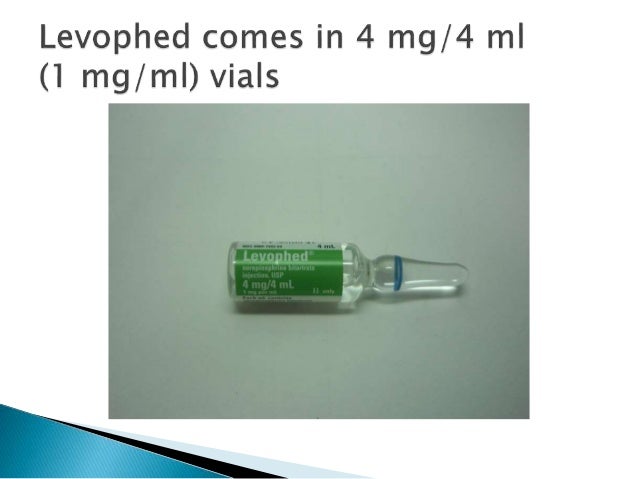
You may report side effects to FDA at 1-80.

Call your doctor for medical advice about side effects. This is not a complete list of side effects and others may occur. Supplied as: Ampuls of 4 mL in boxes of 10, NDC 0409-1443-04. Our Levophed (norepinephrine bitartrate) Side Effects Drug Center provides a comprehensive view of available drug information on the potential side effects when taking this medication. LEVOPHED, norepinephrine bitartrate injection, USP, contains the equivalent of 4 mg base of LEVOPHED per each 4 mL ampul (1 mg/mL). Consult your doctor before breastfeeding. It is unknown if this medication passes into breast milk. Levophed During Pregnancy and Breastfeedingĭuring pregnancy, Levophed should be used only if prescribed. Tell your doctor all medications you use. Levophed may interact with blood pressure medications, MAO inhibitors, or antidepressants. What Drugs, Substances, or Supplements Interact with Levophed?

Dosage is based on the patient's condition and response to treatment.
Levophed drip skin#
Levophed is diluted in liquid and given continuously into a large vein (IV infusion), as directed by the doctor. swelling, blisters, skin sores, or leaking of fluid where the drug is going into your body. dangerously high blood pressure (severe headache, blurred vision, buzzing in your ears, anxiety, confusion, chest pain, shortness of breath, irregular heartbeats, seizure).urinating less than usual or not at all,.sudden numbness/weakness/cold feeling in your body,.pain or burning where the injection is given,.Serious side effects of Levophed include: redness and swelling at the injection site.Tell your doctor if you have serious side effects of Levophed include: Levophed is often used during or after CPR (cardio-pulmonary resuscitation). Levophed (norepinephrine bitartrate) is a vasoconstrictor, similar to adrenaline, used to treat life-threatening low blood pressure ( hypotension) that can occur with certain medical conditions or surgical procedures. If the IV were to infiltrate, give the required subcutaneous dose of tertbutaline to stop the necrosis caused by the norepinephrine.Medical Editor: John P. Administer Norepinephrine (Levophed) 5-20 mcg/min infusion titrate to MAP of. We may sometimes give it in low doses through a large bore peripheral IV while the provider is placing the central line. Norepinephrine is a very potent medication and requires a central line for administration. The guidelines also suggest an IV push-dose of epinephrine 0.1 mg of 1:10,000 over 5 minutes. Alpha Receptors: Vasoconstriction, increased peripheral vascular resistance, and increased arterial blood pressure. Guidelines recommend to administer IV epinephrine if anaphylaxis appears to be severe with immediate life-threatening manifestations, and starting a drip between 1-4 mcg/min.Beta 1 Receptors: Increases myocardial contraction (strength of the heart beat) and increases the heart rate.It is a beta-1 and alpha-adrenergic agonist, meaning it activates those receptors. In this case, keeping the patient's blood pressure normal is the priority. All medications have side effects that may not be desirable. The medication is narrowing the veins (including the renal veins) which causes decreased perfusion to the kidneys. In high doses, norephinephrine can cause acute kidney injury. We check the blood pressure every 15 minutes or continuously (if the patient has an arterial line). The most frequent nursing intervention when this medication is infusing is checking the patient's blood pressure. The dose that we usually give patients is 1-30 mcg/min continuously through a central line.

The brand name of norepinephrine is Levophed. Use the least amount of medication necessary to minimize adverse effects. Titrate the drip until the patient is no longer bradycardic or hypotensive. Luckily, we have learned that norepinephrine is a great medication to treat hypotension if used correctly. The drip rate can be increased every 10 minutes and by 0.05- 0.2 mcg/kg/min as epinephrine is a potent vasoconstrictor. Many of the older nurses have said that they used to say, "Levophed, leave 'em dead." If patients were sick enough to require norepinephrine to manage their shock, then they were most likely going to die. This is advantageous in septic shock patients because their heart rates are already elevated. Norepinephrine will raise a patient's blood pressure but not their heart rate. The majority of our patients requiring this medication are in septic shock. In our ICU, usually the first vasopressor of choice is norepinephrine. Some of the common vasopressors that are used include dopamine, neosynephrine, epinephrine, and norepinephrine. A vasopressor is a medication that literally makes the veins squeeze themselves tighter which raises blood pressure. There are a variety of vasopressors that are used to treat shock in the ICU.


 0 kommentar(er)
0 kommentar(er)
